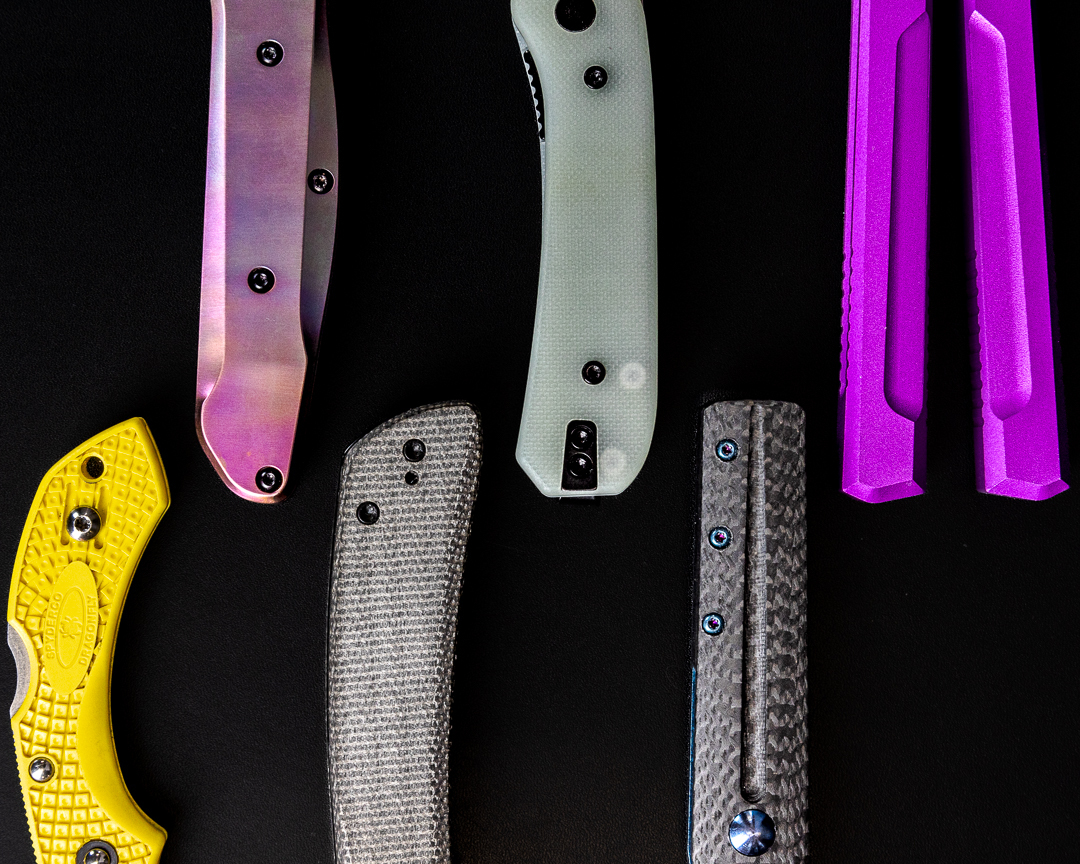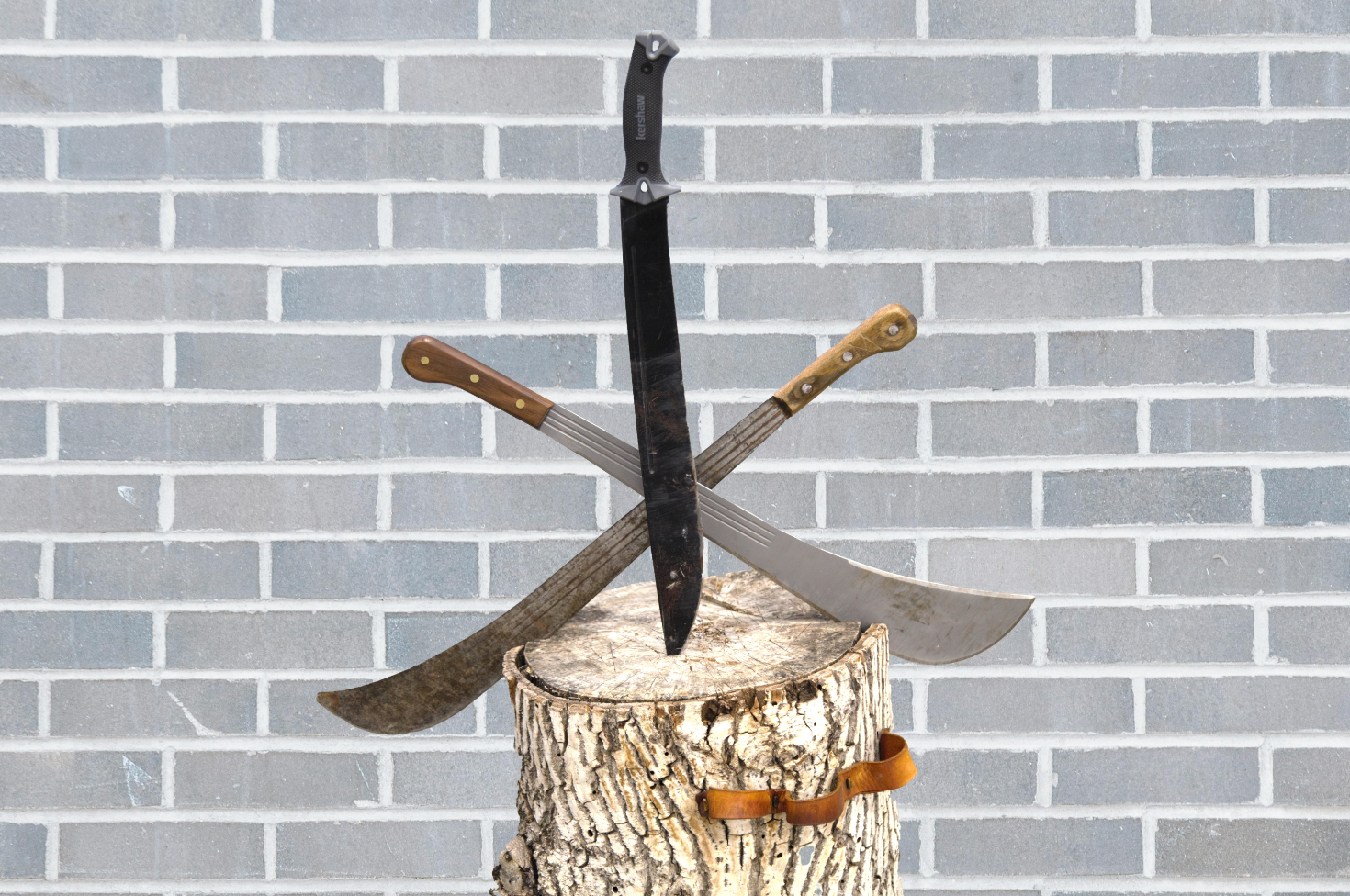
Maybe you’re like me. When I was getting started with my knife collection, I knew what materials I liked best, but I didn’t know why. But I wanted to know.
Or, maybe you’re already a seasoned expert, but you’re always up to learning more.
Or maybe you’ve just been pretending to know the difference between Micarta and G-10, and you want to wise up fast before your knife friends find out.
Either way, there’s a lot to choose from when it comes to knife handles, and it’s smart to be in the know on the latest and greatest as well as familiar with the classics–and the pros and cons of both.
(If this piques your interest, then you’re in the right place. We can talk about this stuff for daaaaaaaayyyss.)
Natural Handle Materials
Wood

There’s something about a knife with a wood handle. It’s just classy, and no two are exactly the same because patterns form naturally over time. Records of particularly dry years, wet years, fires, and frosts can be read in tree rings. Both the concept of this and the resulting patterns are intriguing. The material has been used for handles for centuries.
If you drop a knife with a wooden handle in the water it floats, making it easy to retrieve. But water can also be a disaster for wood, and you must take care of it. Neglecting a wooden handle can make it warp, split, or rot. If you keep the handle mostly dry and give it the occasional coat of oil, you should be fine.
Hardwoods are obviously better than soft woods, and then there’s stabilized wood. It’s made by saturating wood with resin in a vacuum chamber, curing, and adjusting the color. The wood develops phenomenal strength and protection from the elements.
Bone

Case Knives is famous for their bone handles. They put a lot of effort into colors and patterns for their traditional pocket knives, and that’s just where you will find most bone handles—paired with traditional, classic knife designs. You don’t usually find bone on modern fixed blades or folders, but they do turn up occasionally.
Bone is strong, attractive, and durable, but can also be slippery. It’s also porous which can be a problem. Temperature and moisture equal potential disaster, but with care your bone handle can last to fight another day.
Leather

I like the natural grip, look, and feel of a leather handle, and the material can age beautifully over time. But, like wood, you’ll need to take special care of your leather handle, especially when it comes to water.
Leather is porous. If your knife gets wet, let it dry completely and condition the material thoroughly. If you leave it out in the sun, the leather will dry out, leading to cracking. Clean and condition, my friends!
Metal Handles
Steel

Nerves of steel, a steely glance, arms of steel … there’s a reason when writers want to declare someone or something as tough, steel is often used as a metaphor. Strong, durable, and resistant to corrosion, steel handles tend to keep their looks and usefulness. However, they’re also heavy. Now you may think a little pocket sag isn’t a big deal, and maybe it isn’t most of the time, though it isn’t easy on your clothes. However, during hard use you can tire pretty quickly, when wielding your blades for extended periods of time. Also, they can be slippery unless the designer planned elements to reduce that factor. Which they usually do.
But if you’re worried about weight, there’s always …
Titanium

My first introduction to titanium was as a salesgirl at a jeweler. I picked up a watch that was priced at well over a thousand dollars and marveled that something that light could be so expensive. Despite its lightness, titanium is super strong and durable. The metal has a warm feel to it and–one of my favorite details—can be anodized to shine in different, brilliant colors. However, titanium can also be scratched and dinged, is expensive, and–like steel–can be slippery. Once again, texture and other detailed work or inlays can negate the slipperiness.
Aluminum

Aluminum is super light, corrosion resistant, strong, and willing to be drenched in any color your heart desires. Big plus—it’s inexpensive, too. I’m a fan. However, aluminum is softer than other metals, so it chips, dents, and scratches more easily. However, in the age of supersteels, Microtech still chooses to pair aluminum with premium steels–in this case, MagnaCut–for a reason. Aluminum still makes a great handle.
Synthetic Materials
Micarta

Thin layers of linen or paper are soaked in resin, making micarta handles strong and comfortable, with an organic cloth-like feel in the hand. It gets even grippier when wet. Over time, micarta darkens and absorbs hand oils, taking on a beautiful patina. Micarta also takes colors well and doesn’t get brittle with age, and it does very well in wet conditions. It will probably outlast you. However, just make sure you let your knife dry thoroughly before putting it away.
G-10

Much like Micarta, G-10 is made by soaking materials in resin. Instead of linen or paper, G-10 uses fiberglass. It doesn’t absorb water, is almost as light as carbon fiber, is inexpensive, and doesn’t mind a bit of hard use. G-10 also textures well for good grip and won’t crack or break easily. Many people prefer the organic look and feel of micarta to the plastic look and feel of G-10, however.
Carbon Fiber

Carbon fiber is one of my favorite materials in a knife handle. It’s strong as steel but at a fraction of the weight, and it’s unfailingly elegant yet can take on tough chores. Resin coats the woven carbon strands and makes it exceptionally hard, but the process also makes it brittle. Like a diamond, if you stress the carbon fiber handle in just the wrong way, it can cleave or break. Also, carbon fiber tends to be more expensive.
Reinforced Nylon

Nylon is a plastic, but most knife handles made of it are “reinforced” by little shreds of fiberglass mixed in. Super strong and resistant to bending, abrasions, and wear. Knifemakers love this light, and inexpensive material.
This Spyderco was one of our first-thought examples of this material, and Spyderco fans love it. The toughness and lightness make it an ideal pocket knife. The cons would be the plastic look and feel that puts some knife aficionados off.
Ultem

Strong and beautiful, fans of Ultem rave about this material. Ultem is also chemical and heat resistant, and non-porous. We’re big fans here at Blade HQ. Check out our in-depth Ultem article to learn more!
Knives with Ultem aren’t as common as we would like, and they tend to be expensive. Also, you have to like a smoked finish or th the amber/honey color, both with some translucent properties. Non-porosity is great for not taking on water, but it can’t take much of a dye, either.
Cord Wrap

Some handles opt for a wrapping of Paracord, Jute, or some other material instead of handle scales. Usually, this kind of handle gets even grippier when wet. The material is inexpensive and the concept is simple: you get to carry around extra cord around with you in case of emergencies, and you can change the colors whenever your little heart desires.
Want a survival kit? There are paracords with snare wire, tinder, fishing line and more woven right in. You can choose.
Disadvantages would be wear and tear, soaking up liquids, and general uncleanliness. Make sure you unwrap and clean/replace the cord from time to time. Don’t wait for someone to tell you your knife is stinky.
Conclusion and Final Question:
So what is the best material for knife handles?
Good question! That’s probably why you came here in the first place, right? But the answer, as you may have realized by now, is there isn’t one. As with knife blades, take care of your handle and it will serve you well for ages. It’s just some handles need more care than others, and to be used properly in accordance with their abilities.
But in conclusion, we’re outrageously lucky to have the all the classic materials still on the scene, but with the luxury of choice in the new materials with all the ingenuity that comes from science and knife makers. We hope you love what you have and pick up a few new favorites along the way for your collection.
Send us a note and tell us what you love about your knife handle, new or old. We always love hearing from you, and we’re interested in learning from the vast knowledge of the knife community’s hive mind.
Stay sharp, knife friends!
Follow us on Instagram, Facebook, and Twitter for the latest and greatest knives and everyday carry gear.
LEARN MORE
TLDR? Check out the videos below on two of our favorite handle materials. The first video features Zac as he makes custom Micarta scales for his Spyderco Shaman. The second will show you how to dye natural G-10 to make that classy Ben Blue color that takes your breath away.
OTHER BEST KNIFE GUIDES
Still in that information gathering phase? We’ve got a bunch more guides on many different topics! Happy hunting and may you find that one special knife of your dreams.




